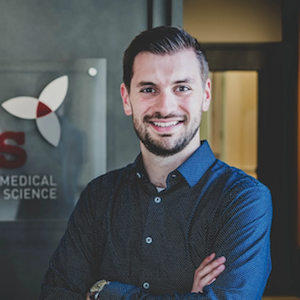
Jeff Peterson
Software Engineer
Jeff Peterson
Software Engineer
Jeff Peterson
Software Engineer
Full Stack Development and Data Science

Full Stack Development and Data Science
Hi. I'm Jeff Peterson. I work in healthcare research as a software engineer tackling all aspects of software-based clinical research projects. Over the past five years, my professional contributions have spanned clinical algorithm development, "full-stack" software development, ML / data science, user interface design, the technical aspects of regulatory submissions (IRB, FDA IDE), medical device integration, human factors engineering, and more. Most recently, I built an application for real-time, bedside clinical decision support.
More information can be found at mgh-cdtl.org.
Project DescriptionBPCi is an application for real-time, bedside clinical decision support. The system aims to provide automated guidance for reducing the duration of hypotension in ICU patients on vasopressors. The BPCi system is comprised of a server and a user interface. The UI is an evolution of the APPRAISE project.
As the sole developer on the project, I built the server and UI. The server application is written in Python and is backed by a PostgreSQL database. The server aggregates all clinical data and calculates several algorithms including the Clinical Decision Support messages (CDS) and the Blood Pressure Control Index (BPCi). The UI is written with a web technology stack (JS/HTML/CSS) and utilizes the React/Redux libraries as well as D3 for plotting. The UI is packaged as a native application using Electron.js. Communication between the server and UI(s) is accomplished using ZeroMQ. Docker is leveraged for automating the build process.
Additionally, I created the 4th iteration of the BPCi algorithm (originally developed at U of Maryland). The algorithms are implemented in Python using Numpy/SciPy. In order to develop a new iteration of the BPCi algorithm, I also built a MATLAB data analysis pipeline. Timeseries vital signs from several hundred subjects, including from MIMIC II, were analyzed. A modified autoregressive model was developed to predict the likelihood of sustained hypotension. This model was analyzed in MATLAB and ported to Python in the application server. This project is awaiting IRB approval for testing in the ICU.
APPRIASE is an application for real-time, bedside clinical decision support. The system provides automated guidance for clinicians during a trauma resuscitation by monitoring data from the bedside monitor and user controls. I built a prototype UI to view the patient’s vital sign trends, the APPRAISE risk strata, and the clinical decision support notifications. The APPRAISE algorithm is a logistic regression model that outputs a risk strata. I developed a new iteration of the model based on a larger dataset, TraumaDB. I assembled TraumaDB by meticulously reconciling all existing trauma project datasets into a standardized schema in PostgreSQL. APPRAISE is IRB approved for use in the MGH ED and is awaiting study deployment.
More information can be found at openice.info and mdpnp.org.
Project DescriptionOpenICE is a prototype clinical ecosystem for connecting medical devices and clinical applications. A multidisciplinary team worked to instantiate a standards-based distributed system and implement proprietary medical device comm protocol translation.
Personal responsibilities included requirements management, designing and developing project website (www.openice.info), development of demonstration software and conference exhibits, medical device integration testing and validation, wrote and maintained user facing documentation, user trainings, and community site implementation and management.
More information can be found at opencommons.uconn.edu.
Project DescriptionModern hospitals are plagued by excessive alarms generated by patient monitoring technologies with very high sensitivity and low specificity. These excessive alarms create high rates of false and clinically irrelevant alarms. Multiple studies have shown that these false and clinically irrelevant alarm rates can negatively impact patient care and lead to "alarm fatigue". For my Master's thesis, I employed a quantitative, database driven approach to alarm management in the acute care and medical/surgical environment with the intent of identifying and implementing technological, clinical, educational, and workflow practice changes to curtail excessive alarming.
I initiated and lead a multidisciplinary committee to analyze the hospital’s current state of clinical alarms, identified several key contributors to nuisance and false alarms through data analysis with R, developed countermeasures with nurses and physicians to safely reduce alarm fatigue, and worked with leadership to implement solutions. Notable results: 24% decrease in alarm duration, system-wide ‘Environment of Care’ goal, satisfied EP1 and EP2 of TJC NPSG 06.01.01
Over the past six years as an engineer, I have built technology to improve patient care and safety.
As lead engineer of the Clinical Decision Technology Laboratory (CDTL) at Massachusetts General Hospital, I am responsible for all aspects of software system development for the laboratory’s clinical decision support applications. This includes clinical algorithm development and testing, “full-stack” software development, user interface design / human factors analysis, regulatory submissions (IRB, FDA IDE), medical device integration, risk analysis, database management, and clinical study deployment. This wide breadth of experiences enables me to contribute to all technical aspects software-based clinical research projects.
In my previous position with Medical Device Plug and Play (MDPnP) Research Lab at Massachusetts General Hospital, I learned a broad set of technical skills that enabled me to build software communication systems. MDPnP is the foremost authority on the safe use of highly interconnected networks of heterogeneous medical devices. I worked on a team that designed and built OpenICE, a novel system that facilitated seamless medical data communication that could dramatically decrease the difficulty in data-driven healthcare research.
While completing my Masters in Biomedical and Clinical Engineering, I learned that technology can have disastrous, safety-compromising affects, even when functioning properly. Humans are as central to the design of healthcare technology as the processors that control them. Whether a patient monitor or decision support software, the interface between healthcare providers and healthcare technology is paramount to the success of the system.
I have amassed a highly specific skillset that uniquely qualifies me to design and develop novel automated decision support systems. As lead engineer of CDTL, I have built software that leverages my knowledge of the complexities of human-device interaction as well as the complexities of computer software development.